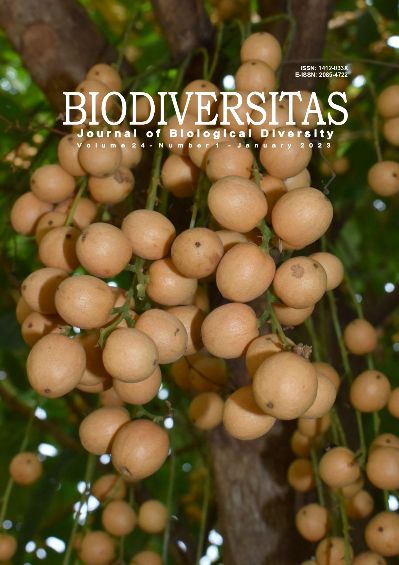Ecolichenology of Eastern Ghats diversity against climatic fluctuations in Kolli Hills, India
##plugins.themes.bootstrap3.article.main##
Abstract
Abstract. Subbaiyan R, Ganesan A, Dhanuskodi S. 2023. Ecolichenology of Eastern Ghats diversity against climatic fluctuations in Kolli Hills, India. Biodiversitas 24: 625-635. Lichens are major components of earthbound and marine environments. A lichen is a symbiotic form of algae and fungi adapted to survive in different altitudes and environmental conditions. The lichen morphology is divided into three, based on their habitat: crustose, foliose, and fruticose lichens. Eastern Ghats (EG) contribute significantly to both the endemicity and species richness of the Indian region. However, EG forests are relatively unexplored and have received less conservation consideration than the Western Ghats. Unexplored Eastern Ghats were studied to analyze the ecolichenology against climatic fluctuations. The objective of this paper is to build a stock of epiphytic lichens within the Kolli slopes. Kolli Hills are one of the ancient richest floral and faunal biodiversity hotspots of Eastern Ghats. It is assessed from the year 2018 to that 2021 with different climatic seasonal variations. The least diversity was found with the Arthonioid > Usneoid > Scaly > Ramalinoid types. Highly denser than the Parmelioid foliose and Usneoid, the Ramlinoid species was rich in numbers with healthy thallus. The population was stopped, or the least amount of thallus growth was noticed from the high rainfall season and gradual reduction in the summer. The Ramalinoid and Parmelioid lichens were found to be easy identifiers. The richness was reduced dependently and independently with nature. The health of lichens was encountered with only morphological appurtenance. Based on the lichen group, the maximum distribution was observed in Usneoid and Ramalinoid categories. The last distribution was found with Leprose and Scaly lichens. The forest wealth was described with the denser lichen patches and the shrinkages of Parmelioid lichens, especially the Dirinaria and Parmoterma, acting as a wealth analysis tool of the forest ecosystems.

